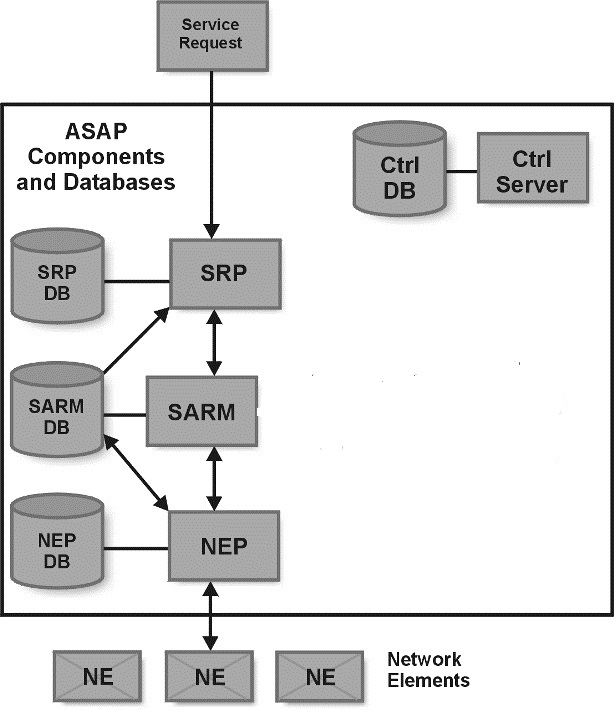1 Development Overview
This chapter consists of the following sections:
Application Architecture
Figure 1-1 outlines how ASAP components interrelate. This figure displays all ASAP application processes (for example, SRP and SARM) and their appropriate databases.
ASAP contains several processes and each process has its own database. Because of this close coupling of a process to its database, ASAP is distributed efficiently in a network environment.
The database engine:
ASAP uses the SQL Server as the database engine. A single SQL Server can contain one or more ASAP databases. In a completely distributed environment, each ASAP database may reside on a separate SQL Server, on a separate machine. This ability to distribute and scale the ASAP application transparently, is a fundamental feature of ASAP's design.
The ASAP control server:
The ASAP Control server manages ASAP's overall operation. The Control server:
-
Starts and stops ASAP applications.
-
Distributes ASAP across many machines.
-
Maintains process and performance statistics about each application.
-
Provides event notification, logging, alarming, and paging facilities that the applications use.
-
Monitors the behavior of application clients and application servers.
-
Issues system alarms to the proper alarm centers if an ASAP application terminates unexpectedly.
Client/Server Architecture
ASAP consists of a set of multithreaded UNIX Client/Server processes that communicate with each other and the associated database servers.
The Client/Server architecture has several advantages over traditional program architectures:
-
Client/Server applications, such as ASAP, are easily distributed across several, possibly heterogeneous, platforms. The applications have a scalable architecture which you can expand upon to meet your future requirements.
-
Application size and complexity is reduced significantly because common services are handled in a single location, by the server. This simplifies client applications, reduces duplicate code, and makes application maintenance easier.
-
Client/Server architecture enables applications to be developed with distinct components. These components can be changed or replaced without affecting other parts of the application. Such components may be supplied as part of the base product or developed by individual customers to suit their own requirements.
-
Client/Server architecture facilitates communication between varied applications. Client applications that use different communication protocols from the server cannot communicate directly with it; instead they must communicate through a “gateway" server that understands both protocols.
Library Architecture
This chapter outlines ASAP's library architecture. The following sections are included in this chapter:
-
ASAP API Development Structure
-
API Library Structures
-
ASAP API Application Development
-
SRP Server Application Structure
-
Generic NEP Application Structure
-
Multi-Protocol NEP Structure
Development of Cartridges Supporting Asynchronous NEs
ASAP processes CSDLs and ASDLs in work orders synchronously. CSDLs and ASDLs are configured sequentially, and an ASDL must complete before the next ASDL can be started.
Some network elements respond to network actions asynchronously. After a request is sent, the receipt of the request may be acknowledged immediately but a response indicating completion of a request may be received from the network element some time later.
An ASDL in which the completion response arrives later is an asynchronous ASDL. A work order may have a mix of synchronous and asynchronous ASDLs mapped to the CSDLs.
Synchronous ASDLs require any previous ASDLs to be completed, so all asynchronous ASDLs run before a synchronous ASDL must complete before the synchronous ASDL starts.
Note:
Asynchronous Dynamic NEs are not supported.
Asynchronous NE interfaces are supported through Java Enabled NEPs.
Asynchronous NE Response Handler
Instead of ASAP managing the processing of asynchronous ASDLs in the core, facilities are provided to the cartridge developer to handle them. These facilities include a response handler to manage asynchronous ASDL responses implemented in the java classes ResponseHandler and ResponseHandlerManager. Refer to the ASAP Online Reference for details on these classes.
When configuring asynchronous ASDLs, a 'stop work order' ASDL must follow the asynchronous ASDL(s) to halt work order processing. The NE response handler handles asynchronous responses from the NE, and resumes the work order when all outstanding asynchronous ASDL completion responses have been received.
Asynchronous connections:
Asynchronous NE interfaces have an entry in table tbl_comm_param with a parameter label ASYNC_CONN and parameter value of either TRUE or FALSE. See "tbl_comm_param."
When the NEP starts, for NEs that have an entry in table tbl_comm_param with a parameter label ASYNC_CONN and parameter value of TRUE, a connection is automatically established. If the parameter value is FALSE, the NE connection is not automatically established.
Each distinct asynchronous NE connection may have a distinct response handler. In this case, when an NE connection is released, then the associated response handler also should be stopped and removed from the system.
If multiple asynchronous NE connections use the same response handler, then the response handler may be spawned during the first NE connection and either left to keep running or stopped and removed from the JNEP by the cartridge developer when conditions as determined by the developer are met.
Response handler manager
Each Java-enabled NEP server (JNEP) uses a single instance of a response handler manager to manage all asynchronous response handlers within the JNEP. The response handler manager is accessed through static methods in its class. Typically, response handler creation is requested within the connect() method of the NE connection classes.
The response handler manager is implemented in the ResponseHandlerManager class. For details, refer to the ASAP Online Reference.
A sample implementation is provided with the ASAP product in
$ASAP_BASE/samples/JeNEP/async_ne
